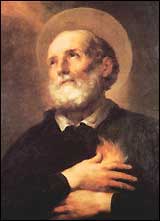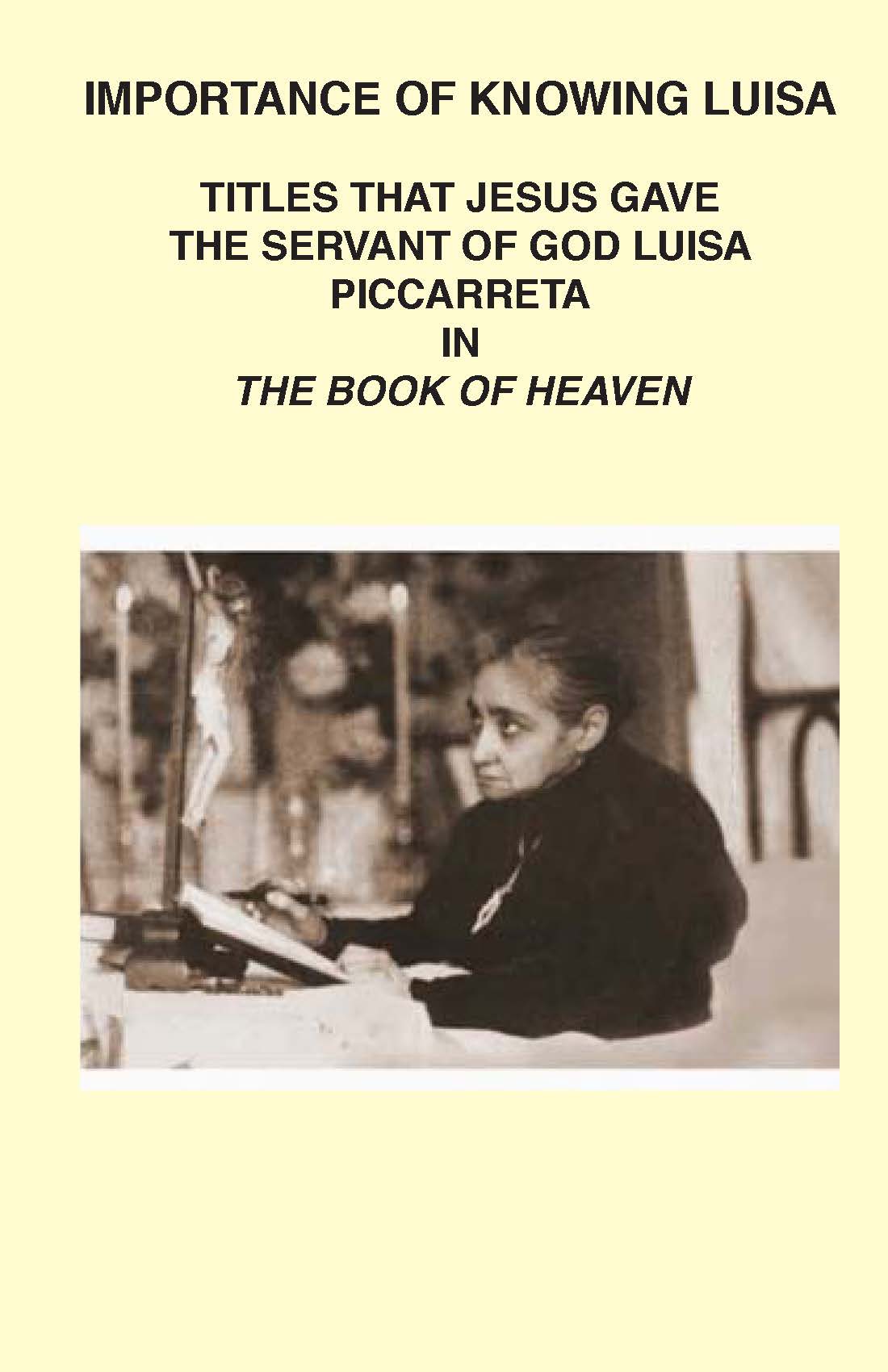FROM THE BOOK OF HEAVEN
V10 – 1.17.11
 “Daughter, what you wrote about the reunions of priests is nothing but a process that I AM making with them. If they listen to Me – fine. But if they don’t, since the leaders of the ecclesiastics will not listen to Me because they too are bound by the laces of interest, and are slaves of human miseries, almost lapping them up – instead of dominating over those miseries, of interest, of high positions and the like, the miseries dominate them; therefore, since they are deafened by what is human, I will be neither understood nor listened to – I will turn to the civilian leaders, who will listen to Me more easily. Because of their desire to see the priest humiliated, and also because maybe these are a little more stripped than the ecclesiastics themselves, my voice will be more listened to; and what they do not want to do out of love, I will make them do by necessity and by force, and I will make the government take away what is left to them.”
“Daughter, what you wrote about the reunions of priests is nothing but a process that I AM making with them. If they listen to Me – fine. But if they don’t, since the leaders of the ecclesiastics will not listen to Me because they too are bound by the laces of interest, and are slaves of human miseries, almost lapping them up – instead of dominating over those miseries, of interest, of high positions and the like, the miseries dominate them; therefore, since they are deafened by what is human, I will be neither understood nor listened to – I will turn to the civilian leaders, who will listen to Me more easily. Because of their desire to see the priest humiliated, and also because maybe these are a little more stripped than the ecclesiastics themselves, my voice will be more listened to; and what they do not want to do out of love, I will make them do by necessity and by force, and I will make the government take away what is left to them.”
And I: ‘My highest and only good, what will be the name to be given to these houses, and what the rules?’
And He: “The name will be: The Houses of the Resurrection of the Faith. As for the rules, they can use the same rules as the Oratory of Saint Philip Neri.”
The Congregation of the Oratory of Saint Philip Neri
The Congregation of the Oratory of Saint Philip Neri is a pontifical society of apostolic life of Catholic priests and lay-brothers who live together in a community bound together by no formal vows but only with the bond of charity. They are commonly referred to as Oratorians (Oratorian Fathers). This “Congregation of the Oratory” should not be confused with the French Oratory, a distinct congregation, the Society of the Oratory of Jesus (Société de l’Oratoire de Jésus), founded by Pierre de Bérulle in 1611 in Paris.
Founded in Rome in 1575 by St. Philip Neri, today it has spread around the world, with over 70 Oratories and some 500 priests. The post-nominal initials commonly used to identify members of the society are “C.O.” (Congregatio Oratorii). The abbreviation “Cong. Orat.” is also used.
Unlike a religious institute (the members of which take vows and are answerable to a central authority) or a monastery (the monks of which are likewise bound by vows in a community that may itself be autonomous and answerable directly to the Pope), the Oratorians are made up of members who commit themselves to membership in a particular, independent, self-governing local community (an Oratory, usually named for the place in which it is located: e.g., Birmingham Oratory, Oxford Oratory, Brooklyn Oratory) without actually taking vows, an unusual and innovative arrangement created by St. Philip. Normally an Oratory must have a minimum of 4 members, 2 being ordained, in order to be founded. If a group of men seeks to establish an Oratory, they may apply to do so, going through the proper diocesan channels; during the process of formation a member (or members) of a well-established Oratory resides in the community to facilitate every aspect of the proposed foundation.
History
The Congregation of the Oratory was founded by St. Philip Neri (1515–1595) in the city of Rome. The first Oratory received papal recognition in 1575.[1] The new community was to be a congregation of secular priests living under obedience but bound by no vows.[2] Speaking of Neri, whom he called, “the saint of joy”, Pope John Paul II said, “As is well known, the saint used to put his teaching into short and wise maxims: ‘Be good, if you can’… .He did not choose the life of solitude; but, in exercising his ministry among the common people, he also wished to be “salt” for all those who met him. Like Jesus, he was equally able to enter into the human misery present in the noble palaces and in the alleys of Renaissance Rome.”[3]
The core of St. Philip’s spirituality focused on an unpretentious return to the lifestyle of the first Disciples of Christ.[4] The object of the institute is threefold: prayer, preaching, and the sacraments.[2]
Up to 1800 the Oratory continued to spread through Italy, Sicily, Spain, Portugal, Poland, and other European countries; in South America, Brazil, India, and Ceylon. Under Napoleon I the Oratory was in various places despoiled and suppressed, but the congregation recovered and, after a second suppression in 1869, again revived.[2] A few houses were founded in Munich and Vienna.
Governance
There are eighty six Congregations of the Oratory throughout the world. Each Community is autonomous, but there is a Confederation which facilitates contact with the Holy See.[1] As such, the Congregation of the Oratory functions more like a monastic federation than like a religious institute.
Three documents govern the Oratory. The first is the “General Statutes” of the Congregation, which are guidelines to be followed throughout the world; these may be changed or modified when representatives from each Oratory gather every six years in a meeting called a “Congresso Generale”. The second is the “Particular Statutes”, which outline how an individual Oratory is to be conducted; these must be approved by Rome. The third document is the “Constitutions”, which establish general norms, and outline the relationship between the Congregation and the Holy See. As the Oratory is a confederation, there is no central authority such as is found within the Dominicans, Franciscans, or Jesuits. The definitive foundation of an Oratorian Congregation is actually done by the Roman Pontiff directly, which makes a Congregation what is called a “Pontifical Right” foundation.[5]
The Confederation elects one of its own to represent the interests of the Congregations to the Holy See; this is done through the Congregation for Institutes of Consecrated Life and Societies of Apostolic Life. This person, known as Procurator General, resides in Rome at the Procura General.
Daily life
An Oratorian resides in an Oratory community of his choosing and is permanently stable, i.e., he is not subject to transfer to other Oratories or communities.[5] Oratorians have what is called ‘stability,’ which means they are committed as members of the community of a particular Oratory, though a member may move if there is a serious enough reason. Unlike the members of a religious institute, Oratorians are not bound by a rule to pray in common, though this is something that Oratorians consider important, and they commit themselves to praying together at least twice each day, and having one communal meal which is usually dinner. Oratorians normally have a set time each day for praying together in silent meditation; this ends classically with the recitation of a litany; they may also celebrate the Eucharist in common. Although some oratories may have a dominant mission (e.g. the London Oratory, which maintains a school), in general the members of the Oratory spend the day involved in various ministries: teaching, parish work, spiritual direction, campus ministry, hospital chaplaincies, administration or maintaining the fabric of the community house. Some oratories are specifically connected with parishes and thus its members serve as clergy of the parish.[5]
The Habit
As Oratorians are secular clergy, they wear roughly the same dress as parish priests. However, the black cassock is fastened with a set of buttons curved from the top to the righthand side. In addition there is a distinctive Oratorian clerical collar which may be worn: white cloth that folds over the collar all around the neck, with a number of folds in, indicating from which particular Oratory a priest originates. The cassock is bound by a sash, called a fascia. The habit is given at formal reception into the community which comes after a few months of living together to see if the candidate fits in well. Members often, but do not necessarily, wear the cassock whilst engaged in their respective ministries, as this may be deemed unsuitable. On such occasions, members of the Oratory would wear the normal street clothes of a cleric, i.e., dark suit, but with the Oratorian collar. In some countries (such as Spain) the distinctive Oratorian cassock and collar was never adopted and there is no way to tell Oratorians from other secular priests.




















